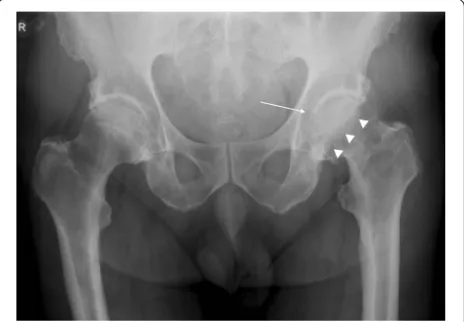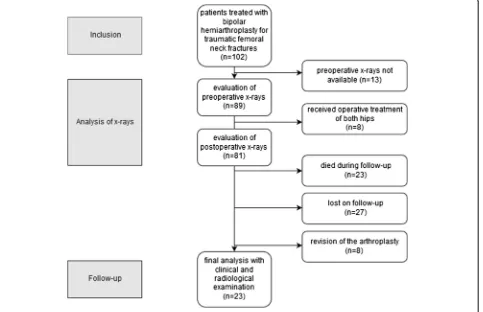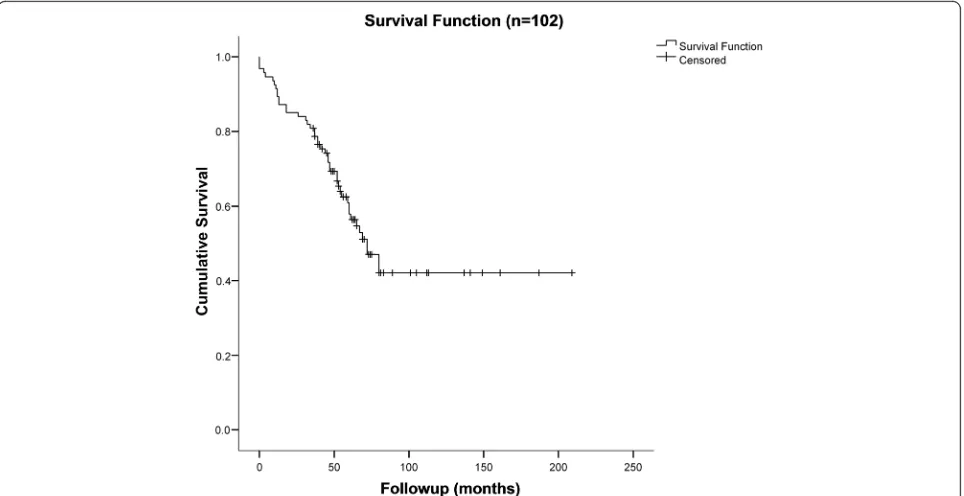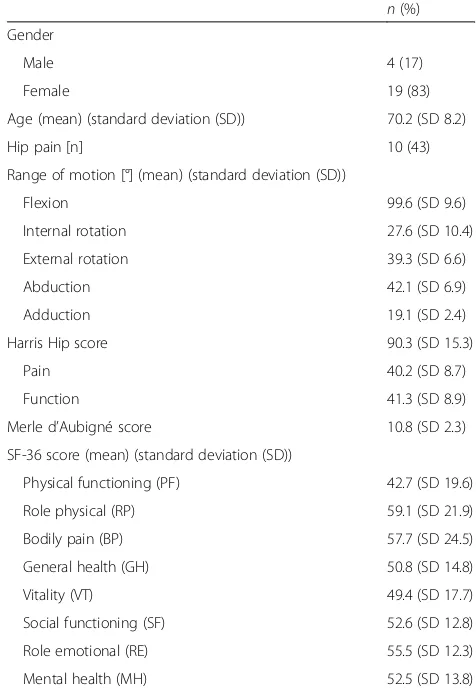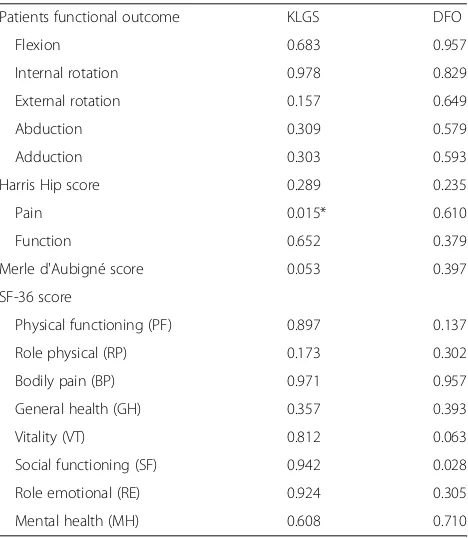R E S E A R C H A R T I C L E
Open Access
The value of modular hemiarthroplasty for
unstable femoral neck fractures in elderly
patients with coxarthrosis
Robert Döring, Thorsten Jentzsch, Max J. Scheyerer, William Pfäffli and Clément M. L. Werner
*Abstract
Background:Displaced femoral neck fractures are common in the elderly patient. The surgical treatment options consist of a hemiarthroplasty (HA) or total hip arthroplasty (THA). However, the best surgical choice is still under debate. Bipolar HAs do not address preexisting arthritic changes of the acetabulum, which may lead to an unfavorable clinical outcome. The purpose of the present study was to conduct a long term follow-up analysis of the bipolar hemiarthroplasty with particular focus on the influence of preoperative acetabular osteoarthritis on the functional outcome.
Methods:In a retrospective observational study, the medical charts of consecutive patients treated with a bipolar hemiarthroplasty at a level one trauma center between 2004 and 2008 were reviewed before a final radiographic and clinical follow-up was performed. The outcome variables consisted of arthritic findings on the pre- and
postoperative x-rays with particular focus on double fond osteophyte (DFO) and posterior wall sign (PWS) as well as the revision rate and functional scores.
Results:This study included 102 patients with a mean age of 77.2 years. Most patients (75 %) had a
Kellgren-Lawrence grading scale (KLGS) of 2 or 3. While only 30 % of patients had a DFO, most patients (73 %) had a PWS. The DFO correlated significantly with the KLGS, but no correlation was seen with the clinical outcome. Most patients showed a decreased offset by a mean of−7.8 mm. The mean modified Harris Hip Score (HHS) of 90.3 and the mean Merle d'Aubigné score of 10.8 correlated significantly. Despite a significant correlation of the HSS subcategory of pain and the preoperative KLGS, there was no statistical relationship between the arthritic x-ray measurements and the clinical outcome.
Conclusions:In the presented study population, the presence of radiographic acetabular osteoarthritis did not influence the clinical outcome after bipolar hemiarthroplasty for displaced femoral neck fractures.
Keywords:Femoral neck fracture, Bipolar hemiarthroplasty, Osteoarthritis and coxarthrosis, Double fond osteophyte (DFO), Posterior wall sign (PWS)
Background
Displaced femoral neck fractures are common injuries of the elderly patient. In western countries, they are treated in nearly every trauma center. Respecting the entities of an aging population and an increasing contribution of developing countries, the estimated worldwide incidence of hip fractures in 2050 is over six million cases per year [1]. Also considering rising insurance costs, femoral
neck fractures represent an important public health problem. It is well known that the most frequently af-fected patient collective of patients older than 60 years is subject to an increased disability, morbidity, and mortal-ity [2, 3]. Therefore, an appropriate fracture treatment is obligatory.
If an operative therapy is indicated, there are two widely accepted options, i.e. monopolar or bipolar hemi-arthroplasty (HA) and total hip hemi-arthroplasty (THA); both with optional use of bone cement. However, the optimal treatment with the best clinical outcome is still * Correspondence:clement.werner@usz.ch
Department of Trauma Surgery, University Hospital Zürich, Rämistrasse 100, 8091, Zürich, Switzerland
under debate [4]. While some authors prefer bipolar HA due to the advantages of smaller dislocation rates, less complex surgery, shorter surgical time, and lower initial costs, recent studies point toward a slightly better func-tion and patient satisfacfunc-tion with THA; especially in healthy elderly patients with good mental conditions [4–13]. This might be explained by different factors. Hemiarthroplasties in general do not address preexist-ing arthritic changes of the acetabulum, which may lead to restriction of movement and hip pain. Further acetabular erosion might occur, potentially resulting in early revision and conversion to THA. Therefore, some authors name osteoarthritis as a contraindication for HA [14], but a recent study showed no correlation be-tween the grade of preoperative osteoarthritis and func-tional outcome scores [15].
In case of bipolar HA, it has been shown that the cup rotates to a relatively constant horizontal position after weight bearing, which is attributed to the overall effect of different factors such as joint geometry, muscle ac-tion, soft tissue, and metal-on-bone friction [4, 16, 17]. Even though the importance of this balanced position for the clinical outcome remains unclear, it might be possible that arthritic changes of the acetabulum, with central osteophytes in particular, result in an aberrance of the head position and lead to restricted range of mo-tion or hip pain [18]. Despite the advantage of modular components to reconstruct a wide spectrum of anatom-ical characteristics and in the management of recurrent dislocations of hip hemiarthroplasty [19, 20], there are still hardware-related disadvantages. One important bio-mechanical feature is the inaccuracy of the femoral off-set, which has been shown to play an important role in the range of motion [21–26] and in functional outcome after hemiarthroplasty [27].
The aim of the present study was to conduct a long term follow-up analysis of bipolar hemiarthroplasty. A particular focus was placed on the preoperative osteo-arthritis of the acetabulum with special attention on the influence of the double fond osteophyte (DFO), the pos-terior wall sign (PWS), and the femoral offset on the functional outcome.
Methods
The study was approved by the local ethics committee (Cantonal Ethic Committee of Zurich, KEK-ZH-Nr. 2011–0320) and written consent was obtained from all patients. All patients with femoral neck fractures, who were treated operatively at a level one trauma center between 2004 and 2008 were retrospectively evaluated. Patients were identified by reviewing medical and surgi-cal records. The time period was chosen to compromise between a long follow-up period, an acceptable num-ber of survivors and the availability of x-rays. A further
inclusion criterion was the implantation of a bipolar hemi-arthroplasty (Mathys AG, Bettlach, Switzerland). Exclu-sion criteria were age younger than 18 years, pathological fractures secondary to malignant disease and polytrauma patients.
In a first step, the preoperative x-rays were evaluated for several variables consisting of typical signs of osteoarthritis, i.e. joint space narrowing, subchondral sclerosis, osteophytes, which particularly included the DFO, cysts as well as the PWS (Fig. 1) [28]. The grade of osteoarthritis was determined using the Kellgren-Lawrence grading scale (KLGS) [29]. Any re-visions of the affected hip were retrieved from the medical charts and patients were asked for revisions during clinical follow-up. In the case of missing data or death, the primary care physician was contacted by phone. Correlations between preoperative osteoarth-ritis and revision rate with THA were calculated.
In a second step, patients were invited to a follow-up examination in the outpatient clinic. In this step, cases with revision of the arthroplasty or conversion to mono-polar HA or THA were excluded in order to compare clinical outcome measures. Patients received a question-naire composed of the scientifically and clinically validated short form (SF)-36-Score, which included the sub-groups of physical functioning (PF), role physical (RP), bodily pain (P), general health perception (GHP), role emotional (RE), social functioning (SF), mental health (MH), and vitality (EF), as well as the Merle-d’Aubigé-Score (MAS), and the modified Harris Hip Score (HHS) [30–32]. A clinical examination of the hip joint was performed in order to determine any localized pain and to assess the range of motion.
In a third step, two standardized x-rays of the pelvis were obtained through an anterior-posterior projection with 20° internal rotation of the legs and an axial
[image:2.595.306.538.532.693.2]table projection. In cases where a follow-up examination was not possible, the last archived x-ray was used. Then, the operated side was compared to the contralateral side with regard to the femoral offset and leg length. Femoral offset was determined by measuring the distance be-tween the center of rotation of the femoral head and the proximal long axis of the femur. In case of arthroplasty the distance between the center of rotation of the fem-oral head and a line bisecting the long axis of the stem was measured. To identify leg length discrepancies, a reference line connecting the upper margin of both acet-abula was drawn. In the following, the perpendicular dis-tance between this line and each minor trochanter was measured and compared.
All data were entered into Excel (Microsoft Corp., Red-mond, USA) and exported to the Statistical Package for the Social Sciences (SPSS) (version 21.0; IBM Corp., Chi-cago, IL, USA) for statistical analysis. Mean values and their standard deviation are given. Differences between particular groups were analyzed using Pearson’s chi-squared test or Mann-Whitney U test and 95 % confi-dence intervals are given. The Spearman’s rank correlation coefficient was used for the comparison of different con-tinuous measures of arthritis and different clinical scores, while the phi coefficient measured the association for
binary measures of arthritis. A value of p< 0.05 was considered statistically significant. All statistics were supervised by a local statistician (Fig. 2).
Results
One hundred and two patients were enrolled in this study. The mean age at the day of the operative treatment was 76.9 (range 43 to 96) years. Seventy-five (74 %) patients were older than 70 years. The sex ratio was 1.0:2.5 (29 (28 %) males to 73 (72 %) females) (Table 1). A total of 44 (43 %) patients had died during the follow up period (Fig. 3). The anatomical side of the fracture was evenly distributed with 54 (53 %) fractures on the left and 48 (47 %) fractures on the right side. Eighty four (82 %) pa-tients received a cemented and 18 (18 %) an uncemented hemiarthroplasty. In 13 (13 %) cases, a revision was neces-sary, whereof nine (9 %) patients received a total hip replacement.
Analysis of preoperative X-rays
Preoperative x-rays of 89 (87 %) patients could be evalu-ated. Most (37 and 38 %, respectively) patients showed a grade of 2 or 3 on the KLGS for osteoarthritis (Fig. 4, Table 2). Double fond osteophytes were present in 31 (30 %) cases; while a positive PWS was found in 74 (73 %)
[image:3.595.60.543.405.717.2]cases. A positive correlation was observed between the ex-istence of DFOs and the KLGS (p< 0.05). There was no correlation between the existence of DFO (phi coefficient 0.15, p= 0.55) or the grade of osteoarthritis (Spearman’s rho 0.05,p= 0.1) and revisions with total hip replacement.
Analysis of postoperative X-rays
Eighty-one (79 %) patients (25 males and 56 females, mean age 76.6 (SD 11.2)) were available for the evalu-ation of a postoperative x-ray since the non-affected hip had also received operative treatment rendering a com-parison unfeasible in 8 cases (Table 3). The mean femoral offset after bipolar hemiarthroplasty was 39.6 (SD 8.5, range 15–58) millimeters (mm). In the majority
(n= 70 (69 %)) of the cases, a decreased offset was noted on the operated side when compared to the contralateral side (Fig. 5). The mean difference of offset was −7.8 (SD 7.9, range −35 to7) mm. The radiologically mea-sured leg length discrepancy was 2.3 (SD 8.0) mm.
Follow-up
Clinical data of 23 (23 %) patients were available for the final analysis. The mean time from the implantation of the bipolar prosthesis to the follow-up examination was 93.9 (SD 45.6) months. The mean modified HHS was 90.3 (SD 15.3) points and the mean Merle d'Aubigné score was 10.8 (SD 2.3) points. There was a statistically significant correlation between both scores (p< 0.001). The points for the SF-36 are shown in Table 3. Further-more, there was a positive correlation between the sub-category of HHS pain and the preoperative grade of osteoarthritis (p= 0.02), but no other statistical relation-ship was found for the remaining scores or clinical mea-sures and preoperative x-ray findings (Table 3 and 4).
Discussion
Femoral neck fractures of the elderly represent an im-portant health care problem. It is widely accepted that an arthroplasty is mandatory for these fractures, but the correct choice of either HA or THA may still be debated in certain cases [4–9]. In contrast to THA, modular HAs are usually implanted in the elderly with less func-tional demands because they are associated with shorter
[image:4.595.56.288.100.253.2]Fig. 3Kaplan-Meier survival curve showing the survival of patients with the cumulative (cum) survival on they axisand the time to death in months on thex axis. Mean for survival time 113.2 months (95 % CI 93.4, 133.0)
Table 1Patient characteristics (n= 102)
n(%) Gender
Male 29 (28)
Female 73 (72)
Age (mean) (standard deviation (SD)) 76.9 (SD 11)
Side of fracture
Left 54 (53)
Right 48 (47)
Cemented hemiarthroplasty 84 (82)
Reoperation 13 (13)
[image:4.595.58.540.454.702.2]surgical duration and less blood loss, which leads to lower revision rates. A combined finite element and clin-ical study by Ichihashi et al. suggested cautious use of bipolar HAs in cases of osteoarthritis due to the migra-tion of the outer head of bipolar HAs [18]. Besides, stud-ies by Sah and Estok as well as Carulli at al. have pointed out the usefulness of dual mobility cup pros-theses in cases of dislocations of HAs [19, 20]. The pur-pose of the present study was to investigate the influence of preexisting acetabular arthritic changes on the clinical outcome after bipolar hemiarthroplasty for displaced femoral neck fractures. The presented results indicate no differences between the radiographic ence of osteoarthritis according to the KLGS, the pres-ence of a DFO or a PWS and the clinical outcome.
Table 2Preoperative x-rays (n= 89, missing 13)
n(%) Gender
Male 25 (28)
Female 64 (72)
Age (mean) (standard deviation (SD)) 77.2 (SD 11.2)
Grade of osteoarthritis according to KLGS
Grade 1 2 (2)
Grade 2 38 (43)
Grade 3 39 (44)
Grade 4 10 (11)
Double fond osteophyte (DFO) 31 (35)
[image:5.595.301.539.384.729.2]Posterior wall sign (PWS) 74 (83)
Table 3Follow-up functional data (n= 23, missing 79)
n(%) Gender
Male 4 (17)
Female 19 (83)
Age (mean) (standard deviation (SD)) 70.2 (SD 8.2)
Hip pain [n] 10 (43)
Range of motion [°] (mean) (standard deviation (SD))
Flexion 99.6 (SD 9.6)
Internal rotation 27.6 (SD 10.4)
External rotation 39.3 (SD 6.6)
Abduction 42.1 (SD 6.9)
Adduction 19.1 (SD 2.4)
Harris Hip score 90.3 (SD 15.3)
Pain 40.2 (SD 8.7)
Function 41.3 (SD 8.9)
Merle d’Aubigné score 10.8 (SD 2.3)
SF-36 score (mean) (standard deviation (SD))
Physical functioning (PF) 42.7 (SD 19.6)
Role physical (RP) 59.1 (SD 21.9)
Bodily pain (BP) 57.7 (SD 24.5)
General health (GH) 50.8 (SD 14.8)
Vitality (VT) 49.4 (SD 17.7)
Social functioning (SF) 52.6 (SD 12.8)
Role emotional (RE) 55.5 (SD 12.3)
Mental health (MH) 52.5 (SD 13.8)
[image:5.595.56.294.563.732.2]To determine the femoral offset, standardized x-rays of the pelvis in anterior-posterior projection with 20° in-ternal rotation of the legs were used. Here, the measured value can easily be underestimated and influenced by hip rotation [33]. A solution was published by Lechler et al., who developed a method of assessing rotation-corrected femoral offsets [34, 35]. However, this method was only used for proximal femoral nailing and is not yet validated for HA. Therefore, and to achieve compar-ability to a larger number of other studies, the projected femoral offset was used in consideration of the accuracy of x-rays. When comparing the femoral offset on the operated and healthy sides, the mean femoral offset was −7.8 mm indicating smaller femoral offsets on the side of the HA. Previous studies have shown that a higher femoral offset leads to a better lever arm for the abductors, which ultimately increases the range of motion [23–26]. This was particularly illustrated in a study by McGrory et al., who showed a significant correlation between the femoral offset and the ab-ductor lever arm, range of motion as well as strength [23]. Furthermore, the restoration of the original fem-oral offset has been shown to be associated with smaller risks of dislocation as well as less strain and decreased wear of the prosthesis in a thorough review by Lecerf et al. [22]. In a recent study, Buecking et al. analyzed the influence of femoral offset on functional outcome in bipolar HA. A mean femoral offset of 36.9 mm was found, which is comparable to the present study (39.6 mm) [27]. However, the positive correlation between femoral offset and HHS could not be reproduced.
[image:6.595.58.539.87.321.2]The proportion of revisions (13 %) was similar to previous studies, which showed substantially higher pro-portions for HAs than THAs [3, 13]. In 9 cases a con-version to THA was performed. Due to the long follow-up period of more than seven years and the advanced age of the study population, definite reasons for these
Table 4Influence of osteoarthritis on functional outcome (p-values, n= 23, missing 79; *p< 0.05)
Patients functional outcome KLGS DFO
Flexion 0.683 0.957
Internal rotation 0.978 0.829
External rotation 0.157 0.649
Abduction 0.309 0.579
Adduction 0.303 0.593
Harris Hip score 0.289 0.235
Pain 0.015* 0.610
Function 0.652 0.379
Merle d'Aubigné score 0.053 0.397
SF-36 score
Physical functioning (PF) 0.897 0.137
Role physical (RP) 0.173 0.302
Bodily pain (BP) 0.971 0.957
General health (GH) 0.357 0.393
Vitality (VT) 0.812 0.063
Social functioning (SF) 0.942 0.028
Role emotional (RE) 0.924 0.305
Mental health (MH) 0.608 0.710
[image:6.595.305.539.463.732.2]procedures could not be evaluated. Nevertheless, pos-sible explanations could include pain, lack of motion or dislocation, which might be related to preoperative osteoarthritis. Still, no correlation could be found. Fur-thermore, the mortality rate of 44 % is in line with a pre-vious study of van den Bekerom, who studied 307 bipolar HAs and reported a mortality rate of 28 % after one and 63 % after five years [3].
The presented overall clinical results according to the HHS and Merle d’Aubigné are good [30, 31]. The aver-age scores of 90.3 in the HSS surpass those of previous studies [10, 12]. For example, Bezwada et al. reported a mean HHS of 82 points after bipolar HA in 248 patients [10]. While 56 % of patients were also pain-free, studies by Bezwada et al. as well as Casserly and Healy stated values around 60 and 69 %, respectively [10, 11]. A po-tential explanation for this lower number of pain-free patients may be attributed to the advanced age, which is usually associated with more comorbidities and longer follow up periods.
There are several limitations to this study. Although a final follow-up clinical visit was scheduled, several pa-tients had been lost in the realm of this retrospective study. This led to rather small subgroups and impeded a meaningful statistical analysis at times. The radiographic femoral offset measurements may have been confounded by rotational differences in our standardized x-rays. Although a goniometer was used for the clinical investi-gation, values had to be rounded to intervals of five degrees, possible leading to measurement errors. Inter-rater discrepancies were also not stratified for. Furthermore, sev-eral comorbidities of this elderly cohort complicated data retrieval at times. Therefore, prospective trials may consider these aspects in their evaluation of the topics presented herein. An example of a future study would consist of a comparison between HA and THA in a large sample size with respect to influence of preoperative arthritic changes on the outcome.
Conclusion
In the presented study population, the presence of radiographic osteoarthritis did not influence the clin-ical outcome after bipolar hemiarthroplasty for dis-placed femoral neck fractures.
Ethics approval and consent to participate
The study was approved by Cantonal Ethic Committee of Zurich, KEK-ZH-Nr. 2011–0320. Written consent was obtained from all participating patients.
Availability of data and materials
All relevant data supporting the conclusions of this art-icle are included within the artart-icle/tables.
Abbreviations
DFO:double fond osteophyte; HA: hemiarthroplasty; HHS: Harris hip score; KLGS: Kellgren-Lawrence grading scale; MAS: Merle-d’Aubigné-score; PWS: posterior wall sign; THA: total hip arthroplasty.
Competing interests
The authors declare that they have no competing interests.
Authors’contributions
RD study design, acquisition, analysis and interpretation of data, drafting the manuscript. TJ analysis and interpretation of data, drafting the manuscript. MS analysis and interpretation of data. WP acquisition and analysis of data. CMLW study design, analysis and interpretation of data. All authors read and approved the final manuscript.
Acknowledgements
None.
Received: 15 October 2015 Accepted: 11 May 2016
References
1. De Laet CE, Pols HA. Fractures in the elderly: epidemiology and demography. Baillieres Best Pract Res Clin Endocrinol Metab. 2000;14:171–9.
2. Hagino H, Nakamura T, Fujiwara S, Oeki M, Okano T, Teshima R. Sequential change in quality of life for patients with incident clinical fractures: a prospective study. Osteoporos Int. 2009;20:695–702.
3. van den Bekerom MPJ, Sierevelt IN, Bonke H, Raaymakers ELFB. The natural history of the hemiarthroplasty for displaced intracapsular femoral neck fractures. Acta Orthop. 2013;84:555–60.
4. Ossendorf C, Scheyerer MJ, Wanner GA, Simmen H-P, Werner CM. Treatment of femoral neck fractures in elderly patients over 60 years of age - which is the ideal modality of primary joint replacement? Patient Saf Surg. 2010;4:16.
5. Burgers PTPW, Geene AR, Bekerom MPJ, Lieshout EMM, Blom B, Aleem IS, et al. Total hip arthroplasty versus hemiarthroplasty for displaced femoral neck fractures in the healthy elderly: a meta-analysis and systematic review of randomized trials. Int Orthop. 2012;36:1549–60.
6. Hopley C, Stengel D, Ekkernkamp A, Wich M. Primary total hip arthroplasty versus hemiarthroplasty for displaced intracapsular hip fractures in older patients: systematic review. BMJ. 2010;340:c2332.
7. van den Bekerom MPJ, Hilverdink EF, Sierevelt IN, Reuling EMBP, Schnater JM, Bonke H, et al. A comparison of hemiarthroplasty with total hip replacement for displaced intracapsular fracture of the femoral neck: a randomised controlled multicentre trial in patients aged 70 years and over. J Bone Joint Surg (Br). 2010;92:1422–8.
8. Keating JF, Grant A, Masson M, Scott NW, Forbes JF. Randomized comparison of reduction and fixation, bipolar hemiarthroplasty, and total hip arthroplasty. Treatment of displaced intracapsular hip fractures in healthy older patients. J Bone Joint Surg Am. 2006;88:249–60. 9. Heetveld MJ, Rogmark C, Frihagen F, Keating J. Internal fixation versus
arthroplasty for displaced femoral neck fractures: what is the evidence? J Orthop Trauma. 2009;23:395–402.
10. Bezwada HP, Shah AR, Harding SH, Baker J, Johanson NA, Mont MA. Cementless bipolar hemiarthroplasty for displaced femoral neck fractures in the elderly. J Arthroplasty. 2004;19(7 Suppl 2):73–7.
11. Casserly HB, Healy B. The Monk Hard-Top prosthesis for displaced intracapsular fractures of the femoral neck. Ir J Med Sci. 1991;160:5–7. 12. McConville OR, Bowman AJ, Kilfoyle RM, McConville JF, Mayo RA. Bipolar
hemiarthroplasty in degenerative arthritis of the hip. 100 consecutive cases. Clin Orthop Relat Res. 1990;(251):67–74.
13. Xu M, Zhang L, Mao Z, Wang H, Chen H, Guo Y, et al. Comparison of effectiveness of three operations in treatment of displaced femoral neck fractures in the elderly patients. Zhongguo Xiu Fu Chong Jian Wai Ke Za Zhi. 2010;24:1419–23.
14. Zi-Sheng A, You-Shui G, Zhi-Zhen J, Ting Y, Chang-Qing Z. Hemiarthroplasty vs primary total hip arthroplasty for displaced fractures of the femoral neck in the elderly: a meta-analysis. J Arthroplasty. 2012;27:583–90.
femoral neck fracture: a prospective observational study. BMC Musculoskelet Disord. 2015;16:304.
16. Lee MS, Chen ACY, Kuo C-H, Tai C-L, Senan V, Shih C-H. The position of the bipolar cup reflects the direction of the hip contact force acting on it. J Arthroplasty. 2007;22:189–94.
17. Phillips TW. The Bateman bipolar femoral head replacement. A fluoroscopic study of movement over a four-year period. J Bone Joint Surg (Br). 1987;69:761–4.
18. Ichihashi K, Imura S, Oomori H, Gesso H. Stress analysis on the acetabular side of bipolar hemiarthroplasty by the two-dimensional finite element method incorporating the boundary friction layer. Nihon Seikeigeka Gakkai Zasshi. 1994;68:939–52.
19. Carulli C, Macera A, Matassi F, Civinini R, Innocenti M. The use of a dual mobility cup in the management of recurrent dislocations of hip hemiarthroplasty. J Orthop Traumatol. 2015.
20. Sah AP, Estok DM. Dislocation rate after conversion from hip hemiarthroplasty to total hip arthroplasty. J Bone Joint Surg Am. 2008;90:506–16.
21. Abraham WD, Dimon JH. Leg length discrepancy in total hip arthroplasty. Orthop Clin North Am. 1992;23:201–9.
22. Lecerf G, Fessy MH, Philippot R, Massin P, Giraud F, Flecher X, et al. Femoral offset: anatomical concept, definition, assessment, implications for preoperative templating and hip arthroplasty. Orthop Traumatol Surg Res. 2009;95:210–9.
23. McGrory BJ, Morrey BF, Cahalan TD, An KN, Cabanela ME. Effect of femoral offset on range of motion and abductor muscle strength after total hip arthroplasty. J Bone Joint Surg (Br). 1995;77:865–9.
24. Yamaguchi T, Naito M, Asayama I, Ishiko T. Total hip arthroplasty: the relationship between posterolateral reconstruction, abductor muscle strength, and femoral offset. J Orthop Surg (Hong Kong). 2004;12:164–7.
25. Charles MN, Bourne RB, Davey JR, Greenwald AS, Morrey BF, Rorabeck CH. Soft-tissue balancing of the hip: the role of femoral offset restoration. Instr Course Lect. 2005;54:131–41.
26. Ebied A, Hoad-Reddick DA, Raut V. Medium-term results of the Charnley low-offset femoral stem. J Bone Joint Surg (Br). 2005;87:916–20. 27. Buecking B, Boese CK, Bergmeister VA, Frink M, Ruchholtz S, Lechler P.
Functional implications of femoral offset following hemiarthroplasty for displaced femoral neck fracture. Int Orthop. 2015.
28. Reynolds D, Lucas J, Klaue K. Retroversion of the acetabulum. A cause of hip pain. J Bone Joint Surg (Br). 1999;81:281–8.
29. Kellgren JH, Lawrence JS. Radiological assessment of osteo-arthrosis. Ann Rheum Dis. 1957;16:494–502.
30. d’Aubigné RM, Postel M. The classic: functional results of hip arthroplasty with acrylic prosthesis. Clin Orthop Relat Res. 2009;467:7–27.
31. Harris WH. Traumatic arthritis of the hip after dislocation and acetabular fractures: treatment by mold arthroplasty. An end-result study using a new method of result evaluation. J Bone Joint Surg Am. 1969;51:737–55. 32. Haddad RJ, Cook SD, Brinker MR. A comparison of three varieties of noncemented porous-coated hip replacement. J Bone Joint Surg (Br). 1990;72:2–8.
33. Meyer C, Kotecha A. Failure to correct femoral anteversion on the AP pelvis radiograph leads to errors in prosthesis selection in total hip arthroplasty. Radiogr Off J Aust Inst Radiogr. 2008;55:17.
34. Lechler P, Frink M, Gulati A, Murray D, Renkawitz T, Bücking B, et al. The influence of hip rotation on femoral offset in plain radiographs. Acta Orthop. 2014;85:389–95.
35. Buecking B, Boese CK, Seifert V, Ruchholtz S, Frink M, Lechler P. Femoral offset following trochanteric femoral fractures: a prospective observational study. Injury. 2015;46 Suppl 4:S88–92.
• We accept pre-submission inquiries
• Our selector tool helps you to find the most relevant journal • We provide round the clock customer support
• Convenient online submission • Thorough peer review
• Inclusion in PubMed and all major indexing services • Maximum visibility for your research
Submit your manuscript at www.biomedcentral.com/submit
